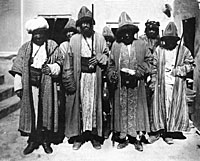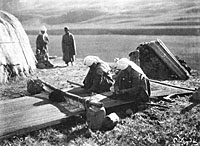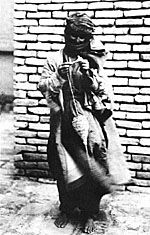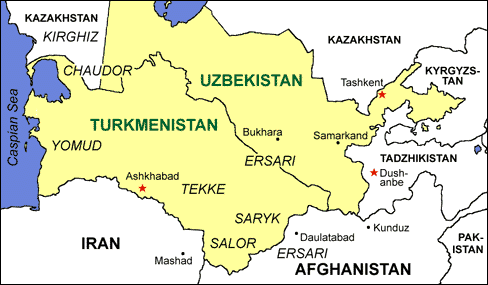Oriental Rugs and Rug Weaving in Turkmenistan and Uzbekistan
Rugs have been woven for centuries in "Turkestan," the area east of the Caspian Sea, north of Iran and Afghanistan, and west and southwest of Chinese Mongolia. The old silk road from Baghdad to Tehran to Ashkhabad, Samarkand, and Tashkent bisects this territory, and was traveled by generations of traders carrying goods between China and the West. The route became known to Europeans following Marco Polo's exploits, and by the early 1800's there are travelers' tales of the people living here.
This is rugged territory, with the Kara Kum Desert hard against the Caspian Sea in the west and the Kizil Kum Desert north of Bukhara tailing off into the high elevations of the Hindu Kush and the Pamir mountains. The landscape is often bleak, windswept, and arid, with heat in the summer and punishing cold in the winter. The population density is low, and the people are pastoralists rather than farmers. Until very recently most people were are least semi-nomadic, traveling a fixed route with their sheep, goats, horses, and camels that took them down into sheltered valleys in the winters and back up to better pastures in the mountains in the summer. These people were incredibly self-sufficient. They used the leather and wool their animals produced to completely equip themselves with clothing, tents, and the assorted gear it took to setup and move camp five or six times a year. Among the items they learned to make and to trade to the outside world were very distinctive wool rugs.
Almost all the trade in Turkoman-style rugs these days is through Iran, Afghanistan, or Pakistan. Many of the Turkoman-style rugs we see in the bazaar markets in Pakistan may well have been woven in Turkmenistan or southern Uzbekistan, and brought south over the old trade routes.
Look at the Weaving in Afghanistan page for a sense of what current Turkoman and Uzbek production looks like, and how these rugs are made. Compare weaving today with the photographs here taken in 1901 and 1902 by Samuil M. Dudin, a Russian collector and amateur ethnologist. Not much has changed!
Life in "Turkestan" in 1900….
Photos by S.M. Dudin
 Turkoman horseman. Turkomans were organized by family into tribal groups. The Russians knew these men to be fierce fighters. Turkoman horseman. Turkomans were organized by family into tribal groups. The Russians knew these men to be fierce fighters. |
 Citizens of the villiage of Shakhrisyabz, south of Samarkand in present-day Uzbekistan. Citizens of the villiage of Shakhrisyabz, south of Samarkand in present-day Uzbekistan. |
 Moving camp. The yurt (the family's felt tent) is loaded on the packhorse. Moving camp. The yurt (the family's felt tent) is loaded on the packhorse. |
 A ground loom next to a yurt. When the family moved, the loom and partially completed rug were rolled up and carried by a horse or camel. A ground loom next to a yurt. When the family moved, the loom and partially completed rug were rolled up and carried by a horse or camel. |
 Spinning wool into yarn with a drop spindle. Spinning wool into yarn with a drop spindle. |



